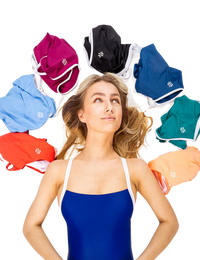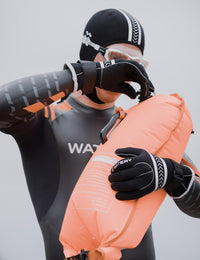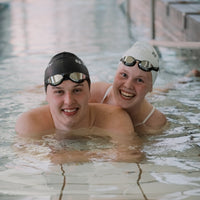Little children
Before we start looking at all the different aids that make it easier for children to learn to swim, it should be mentioned that none of these products are rescue aids. They are only flotation aids and must therefore always be used under supervision. So we just got the most grown-up part sorted out, so let's dive into the children's world.
Because when it comes to young children, children between the ages of 2-6 are most often thought of, but all aids depend to a much greater extent on weight. Therefore, it is much more important to choose based on the child's real weight and not on weight and age statements. Because if the child weighs too much in relation to what is indicated, the aid will not provide the necessary buoyancy. If the child weighs too little, the buoyancy will be too great for the child to get anything out of it.
But what are the various aids? Well, let's start with the most common ones:
Swimming belts
Swimming belts is one of the most effective ways to keep your child afloat. They provide a good and natural position in the water without getting in the way of swimming strokes or kicks. There are different models that can basically do the same thing, but still have their differences. The last one should have its own category.
Beco swimming belt-mono is the most classic and best-known swimming belt, as they are the ones you find in almost all swimming pools. They are divided into colors according to weight and from 2-3 years (15-18kg) it is the red one you should go for. It is easy to adjust, has a good fit and a good width, which ensures an evenly distributed buoyancy of the body - nothing above, nothing below.
Beco neopren - Sealife is for some just the level above the Mono Swimming Belt. It is made of neoprene with a layer of foam that provides extra good buoyancy.
Swimfin Hajfinne is a different type of swimming belt that can seem more fun for children to swim with. It keeps the child stable on the surface of the water and is even designed so that they can also swim on their back with it.
These are some of the most common swimming belts, all well tested and known to work on learning to swim. The advantage of a swimming belt is that it provides a natural lift, so that over time it becomes easier to do without when you have to swim without aids. But often you don't just use a swimming belt, which leads us on to the next category.
Arm wings
Arm wings - which are also called bathing wings - are some of the most well-known buoyancy aids. You often see them with smaller children on holiday or in the swimming pool, and for good reason. Because not only do they keep the child above water, they also give the head a natural position above the water. The advantage of arm wings is that they are mainly made to keep just the head above water, but "force" the child to keep the rest of the body above the surface of the water, in order to be able to swim and create propulsion.
Therefore, they learn more naturally to keep their body and legs above the surface of the water, which gives them an advantage when they are ready to throw away the flotation aids. So let's take a look at what different arm wings are available:
Beco swimming fins are probably some of the most well-known on the market with their orange colour. The smart thing about them is that they are inflatable, so they are easy to carry in your bag without taking up too much space. Their orange colors also help to create visibility, so you can always see where the child is in the water and thus avoid accidents.
Beco swimming wings for children -Sealife is for those who want a safe and longer-lasting buoyancy. As they consist of foam, they will not become "flat" during use, which inflatable swimming wings do. Therefore, they are also more stable, as they will always deliver the same buoyancy and do not need to be inflated. The disadvantage of this, however, is that they take up more space in a possible travel bag.
Malmsten batg wings for children - Flipper is a bit the same as those from Beco, just in a different design. They also consist of foam, but in a more continuous piece. In addition, they can be tightened and the whole design therefore provides a strong and more even buoyancy. Since they can be turned both towards the body and away from the body, they can be set to provide the best buoyancy in relation to the swimming level the child is at.
Many will initially combine swimming wings with a swimming belt, especially for the very smallest. It provides the most effective buoyancy and will keep children without swimming abilities naturally on the surface of the water. In fact, it becomes impossible for them to sink or get their heads under water. Therefore, this combination is also the safest, as it will both keep the legs, lower and upper body above the water surface and will keep the child afloat, even if they are not moving in the water.
If you want to get a complete set with the two properties, you will a float kit certainly be worth preferring. And if you combine it all with a wetsuit, it will give an extra buoyancy. They are most often used for smaller children, so that they can better retain the heat and their skin is not exposed to harmful UV rays. But in addition, neoprene also has a natural buoyancy, as it consists of air bubbles. Therefore, children get an extra boost.




















![[FREE GIFT 1] Watery earplugs](http://watery.ie/cdn/shop/files/activeearplugs-clear-1-klartilhjemmeside_1_cb768001-5d23-4761-b00b-4c79f9e61c90.jpg?v=1733734701&width=200)
![[FREE GIFT 2] Watery Anti-Fog Spray](http://watery.ie/cdn/shop/files/1_8ad7b1cc-6955-4108-9f1a-8001285ee86e.jpg?v=1732816343&width=200)
![[FREE GIFT 3] Watery waterproof mobile case - Storm - Black](http://watery.ie/cdn/shop/files/Designudennavn_16_7b517ddd-25a8-4cfe-8af8-91b851f3ce89.png?v=1725466521&width=200)
![[FREE GIFT 4] Watery waterproof bum bag - Talia - Blue](http://watery.ie/cdn/shop/files/WateryTaliaBumBag-Blue_1_d4bbce92-9e6b-44e3-b32c-527b0720cb62.jpg?v=1727807316&width=200)